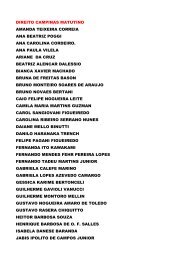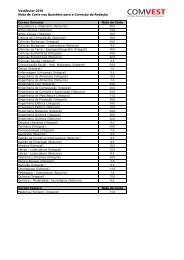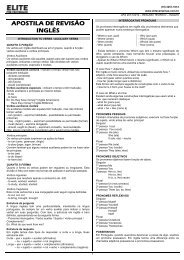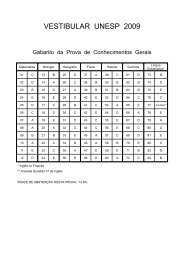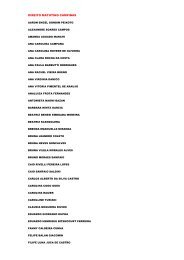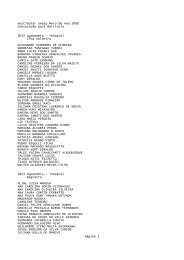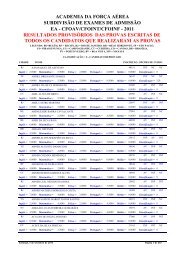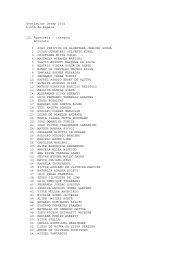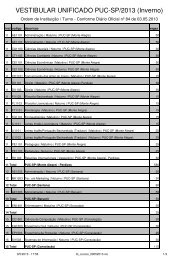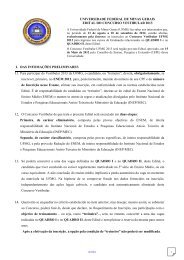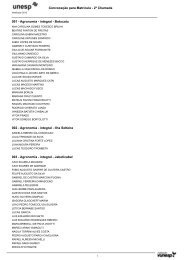FUVEST 2004 PRIMEIRA FASE - Elite Pré-Vestibular-Campinas
FUVEST 2004 PRIMEIRA FASE - Elite Pré-Vestibular-Campinas
FUVEST 2004 PRIMEIRA FASE - Elite Pré-Vestibular-Campinas
You also want an ePaper? Increase the reach of your titles
YUMPU automatically turns print PDFs into web optimized ePapers that Google loves.
ELITE<br />
PRÉ-VESTIBULAR<br />
• A três amostras, adicionou-se, gradativamente, solução de Br2,<br />
até perdurar tênue coloração marrom. Os volumes, em mL, da<br />
solução de bromo adicionada foram: 42,0; 42,0 e 21,0,<br />
respectivamente, para as amostras dos frascos X, Y e Z.<br />
• As três amostras restantes foram tratadas com O3 e, em<br />
seguida, com H2O2. Sentiu-se cheiro de vinagre apenas na<br />
amostra do frasco X.<br />
O conteúdo de cada frasco é:<br />
Alternativa B<br />
A partir das estruturas apresentadas, a substância I é o dieno 1,4hexadieno,<br />
a substância II é o cicleno cicloexeno e a substância III é o<br />
dieno 1,5-hexadieno, ou seja, hidrocarbonetos de fórmula molecular<br />
C6H12. Assim, conclui-se que o cicloexeno (amostra II) corresponde à<br />
amostra Z porque sua reação de bromação ocorre numa relação<br />
estequiométrica de 1:1 porque apresenta apenas uma ligação π<br />
enquanto os dienos estabelecem uma relação de 2:1 para a bromação<br />
porque apresentam duas ligações π. As reações de adição que<br />
ocorrem podem ser representadas pelas seguintes equações:<br />
C<br />
H 2<br />
C<br />
H 2<br />
CH 3<br />
1 Br 2<br />
CH 2<br />
2 Br 2<br />
2 Br 2<br />
O tratamento destas substâncias em meio oxidante com ozônio e<br />
peróxido de hidrogênio produziria o rompimento das ligações σ e π dos<br />
hidrocarbonetos e substâncias com o grupo carbonila caso fosse<br />
também utilizado zinco. Uma vez que esse redutor não foi empregado<br />
nos experimentos, o meio oxidante transformará a carbonila de<br />
aldeídos em grupos carboxila. Assim, a ozonólise do cicloexeno<br />
produzirá o ácido hexanodióico conforme a seguinte equação:<br />
O 3<br />
H 2 O 2<br />
Br<br />
Br<br />
Br<br />
Br<br />
Br<br />
Br<br />
Br<br />
COOH<br />
COOH<br />
Br<br />
Br<br />
ácido hexanodióico<br />
Considerando que apenas o recipiente X apresentou odor de vinagre<br />
após a oxidação e que este odor é característico de ácido etanóico<br />
(ácido acético), é necessário avaliar qual dos dienos leva à formação<br />
deste ácido carboxílico após a ozonólise. Uma vez que ozonólise de<br />
alcenos terminais gera dióxido de carbono conclui-se, então, que X<br />
corresponde ao dieno I e Y ao dieno III de acordo com as seguintes<br />
equações:<br />
C<br />
H 2<br />
C<br />
H 2<br />
CH 3<br />
CH3 O3 H2O2 CO2 + H2 O +<br />
HO<br />
O<br />
O O<br />
O<br />
+<br />
H3C OH<br />
OH<br />
ácido etanóico<br />
(substância responsável<br />
pelo odor de vinagre)<br />
CH2 O3 H2O2 HO<br />
OH + 2 CO2 + 2 H2O<br />
INGLÊS<br />
O<br />
Br<br />
<strong>Campinas</strong><br />
O ELITE RESOLVE <strong>FUVEST</strong> <strong>2004</strong> – <strong>PRIMEIRA</strong> <strong>FASE</strong> – PROVA V<br />
Texto para as questões de 1 a 4<br />
From Susan Blackmore<br />
In his article on computers and consciousness, Igor Aleksander was<br />
quite wrong to say that “Susan Blackmore...implies that constructing a<br />
machine that is conscious like us would be impossible” (19 July, p 40).<br />
I do indeed claim that consciousness is an illusion. This is<br />
because it feels to us humans as though there is a continuous flow of<br />
experiences happening to an inner self, when in fact, there is no such<br />
inner self.<br />
Computers have no inner self either, but if ever they start thinking they<br />
do they will become deluded like us, and hence conscious like us. And<br />
that day is surely not far off.<br />
We humans can sometimes wake up from our delusion,<br />
through intellectual insight or through practices like meditation. Maybe<br />
future computers will teach us a thing or two about waking up from<br />
illusion.<br />
Bristol, UK<br />
(New Scientist, August 9, 2003)<br />
81. The author of the text criticizes<br />
a) the construction of machines that resemble human beings.<br />
b) human expectations of mastering technology completely.<br />
c) an idea presented in a previous article published by New Scientist.<br />
d) experiments made with humans and computers.<br />
e) the illusions created by those who construct computers.<br />
Alternativa C<br />
O Texto começa fazendo referência a outro artigo, de Igor Alexander,<br />
e a autora afirma “... Igor Alexander was quite wrong to say...”, levando<br />
à letra C como resposta correta, afinal a autora critica uma posição<br />
dada em outro artigo.<br />
82. In her letter to the editor, Susan Blackmore claims that<br />
a) computers are deluded in the same way human beings are.<br />
b) building computers with a certain degree of consciousness will be<br />
possible in the future.<br />
c) human consciousness is changing the kind of experiences that flow<br />
into an inner self.<br />
d) human beings are deluded in their belief that they possess an inner<br />
self.<br />
e) computers and humans will develop a new kind of consciousness<br />
one day.<br />
Alternativa D<br />
A resposta para a questão é a letra D pois no trecho “there is no such<br />
inner self” afirma-se que não há um eu interior, apesar dos humanos<br />
acreditarem nisso.<br />
83. Susan Blackmore says that<br />
a) intellectual insight and practices like meditation can help us become<br />
aware of our delusion.<br />
b) computers will help humans increase their intellectual expertise in<br />
the future.<br />
c) meditation and similar practices are helpful for people who spend<br />
long hours in front of computers.<br />
d) people easily fall into the illusion that computers will solve most of<br />
their problems.<br />
e) computers are necessary in people’s lives to free them from their<br />
illusion of an overpowering consciousness.<br />
Alternativa A<br />
18



